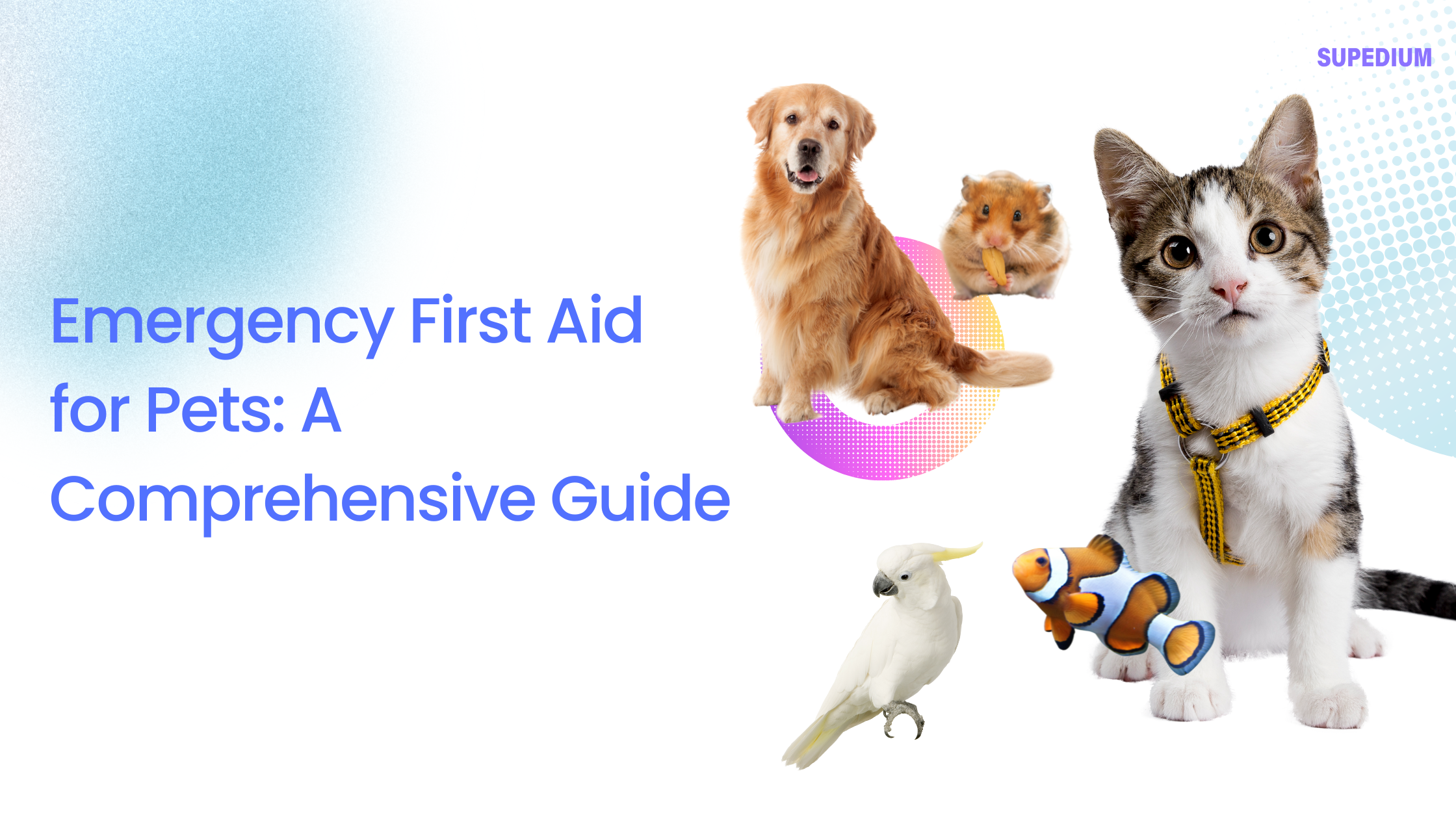Table of Contents
![]()
Introduction
When our pets face emergencies, the quick and knowledgeable response of their caregivers can make a critical difference. Pet first aid is essential not only for addressing immediate injuries and health issues but also for potentially saving a life. This guide covers the basics of pet first aid, including preparation, assessment, treatment of common emergencies, and specific considerations for different types of pets.
Preparing for Emergencies
Creating a Pet First Aid Kit
A well-stocked pet first aid kit is indispensable for addressing emergencies. Essential items include:
- Bandages: Various sizes for different injuries
- Antiseptic: For cleaning wounds
- Tweezers: For removing splinters or foreign objects
- Thermometer: To monitor body temperature
- Gauze Pads and Tape: For dressing wounds
- Scissors: To cut bandages or tape
- Emergency Blanket: For warmth and shock prevention
- Hydrogen Peroxide: For inducing vomiting (only when directed by a vet)
Tailor the kit to your pet’s specific needs, considering items like a muzzle for aggressive animals or a specialized splint for exotic pets.
Knowledge and Training
Taking a pet first aid course is invaluable. These courses cover vital skills such as CPR and wound care, and they provide hands-on experience. Understanding basic pet anatomy and common health issues helps in effectively assessing and treating emergencies.
Assessing the Situation
Initial Evaluation
Begin by assessing the situation calmly. Observe your pet for signs of distress, such as unusual vocalizations, limping, or signs of pain. Ensure your safety and that of your pet—approach them cautiously, especially if they are frightened or in pain, as they might react aggressively.
Determining the Severity
Prioritize care based on the severity of the situation. Life-threatening conditions, such as severe bleeding or difficulty breathing, require immediate attention and should be addressed first.
Common Emergencies and First Aid Responses
Wounds and Bleeding
- Minor Cuts and Scrapes: Clean the wound gently with mild soap and water. Apply an antiseptic and cover with a sterile bandage to protect against infection. Change the bandage regularly and monitor for signs of infection.
- Severe Bleeding: Apply firm pressure to the wound with a clean cloth or bandage. Elevate the injured limb if possible. If bleeding doesn’t stop within a few minutes, seek emergency veterinary care immediately.
Choking
For choking pets, especially dogs and cats, you can attempt the following:
- Dogs: Perform abdominal thrusts by placing your hands just below the ribcage and applying quick, firm pressure. If the obstruction is visible and easily reachable, remove it carefully.
- Cats: Place the cat on a firm surface, and use your fingers to clear the obstruction if visible. Gently use abdominal thrusts if the object cannot be removed.
Burns and Heatstroke
- Treating Burns: Cool the burn immediately with lukewarm water. Do not use ice. Cover the burn with a sterile dressing to protect it from infection. Avoid applying ointments or creams unless instructed by a vet.
- Recognizing and Treating Heatstroke: Symptoms include excessive panting, drooling, and lethargy. Move the pet to a cooler area, apply cool (not cold) water to their body, and provide small amounts of water to drink. Contact a vet as soon as possible.
Poisoning
Common toxins include chocolate, certain plants, and household chemicals. Symptoms of poisoning can vary but may include vomiting, diarrhea, and lethargy. If poisoning is suspected, induce vomiting only if advised by a veterinarian and contact an emergency vet immediately.
Fractures and Sprains
- Immobilizing the Limb: If you suspect a fracture or severe sprain, immobilize the affected limb with a splint or makeshift support using materials like rolled-up newspapers or cloth. Avoid moving the pet unnecessarily and seek veterinary care promptly.
Seizures
During a seizure, keep your pet safe by removing potential hazards from their vicinity. Do not attempt to restrain them or place anything in their mouth. Timing the seizure and reporting its duration to your vet is crucial for diagnosis and treatment.
Specific Considerations for Different Pets
Dogs
Dogs can have breed-specific health issues that may affect first aid. For example, brachycephalic breeds (like Bulldogs) may have unique breathing difficulties that need special attention.
Cats
Cats often hide their pain, so careful observation is key. Common injuries in cats include bite wounds and falls. Always approach injured cats with caution, as they may react unpredictably.
Exotic Pets (Birds, Reptiles, etc.)
Exotic pets have unique needs. For birds, monitor for signs of respiratory distress or feather damage. Reptiles may need specific temperature adjustments. Handling and first aid techniques vary, so familiarize yourself with your pet’s specific requirements.
When to Seek Veterinary Care
Recognizing Signs That Require Professional Help
Seek veterinary care if your pet shows persistent symptoms, severe trauma, or is unresponsive. For severe cases like prolonged seizures or major trauma, immediate professional intervention is essential.
Finding and Contacting Emergency Veterinary Services
Locate the nearest emergency veterinary clinic ahead of time. Keep their contact information accessible. In emergencies, every second counts, so having a plan in place ensures you can act quickly.
Preventative Measures
Regular Check-ups and Vaccinations
Routine veterinary check-ups and vaccinations help prevent many emergencies by keeping your pet in good health and preventing common diseases.
Pet-proofing the Home
Reduce risks by pet-proofing your home. Secure hazardous chemicals, keep toxic plants out of reach, and ensure small objects that could be swallowed are kept away.
Pet Safety Awareness
Educate yourself and others in your household about common pet risks and safety practices. Awareness and prevention are crucial components of pet care.
Conclusion
Being prepared for emergencies and knowledgeable in pet first aid is vital for ensuring the safety and well-being of your furry friends. By understanding the basics of first aid, creating a well-equipped kit, and knowing when to seek professional help, you can confidently manage emergencies and provide the best care for your pets.
Share This





Be the first to comment